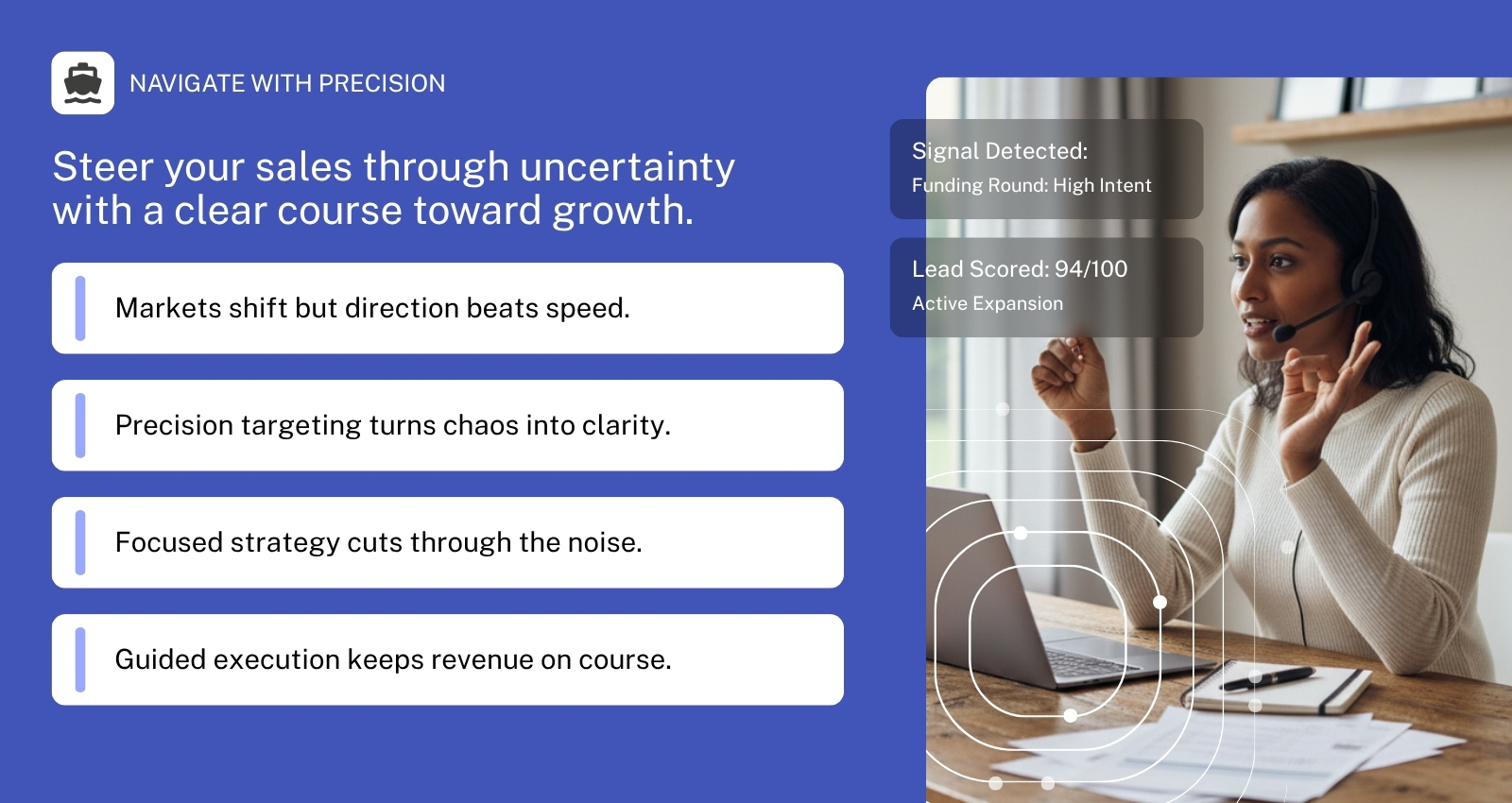

How to Build a Winning SDR Team: The Ultimate Guide
[blog_at_glance]
Building a high-performing Sales Development team is critical to the success of any B2B business, but the question of whether to outsource or build an in-house team can be a difficult one to answer.
At Punch!, we've heard this question from many b2b companies over the years, which is why we created our latest guide on how to build a winning SDR team.
This guide covers everything you need to know to build your very own winning SDR team. From the challenges you'll face when getting started, to the exact roles you'll need, and how to hit the ground running. Plus, we're revealing the common mistakes to avoid, so you can achieve your goals.
Table of contents
- The challenges of building a winning in-house SDR team
- The challenges of maintaining a winning in-house SDR team
- Building your team: your winning line up
- The SDR Success Formula
The challenges of building a winning in-house SDR team

Building a winning in-house SDR team requires considered planning. Here are some of the key challenges you’ll come to face when getting started.
Hiring the wrong people
It’s crucial to have the right blend of talent; as well as SDRs, you’ll need strategy, tech ops and data research. You’ll also need more than one SDR to create a buzz and build a competitive spirit.

Discover the exact roles you'll need to build your SDR dream team and why missing crucial roles is a mistake in our Ultimate Guide. Download it here!
Appropriate budgeting
Making the required investment Knowing how much to invest, and when you can expect to see a return, requires strategic know-how, leaving many to start small but not see results. Skimping may seem like a good idea, but will set you back in the long run.

Use our SDR hire calculator to plan your resource investment. View it here!
A poor MarTech stack
Investing in the right MarTech stack is critical for driving productivity, efficiency, and success. However, selecting and implementing the right tools can be a challenge, requiring you to evaluate multiple options and ensure seamless integration with your existing systems.
Hiring SDRs before leadership
It’s no good having an SDR team with no clear direction. Hiring your ‘back room team’ including a sales development manager and strategist is important to ensure your SDRs are set up for success.
Time commitment
Building a winning SDR team takes a significant amount of time, effort, and resource. On average, it can take up to 3 to 4 months to ramp up a new SDR team before seeing results.
Lack of expertise & wrong go-to-market strategy
Developing a sales development strategy that aligns with your business objectives and target accounts requires careful planning, expertise and execution. Falling short on this can give your competitors the edge.
Lack of internal processes
If the SDR team do not have documented internal processes, including CRM and tech usage, lead handoff, reporting, and performance metrics then problems can occur. Processes must be well-defined and communicated to ensure everyone is on the same page.
The challenges of maintaining a winning in-house SDR team

So you’ve built your team and have developed your strategy, game won right? Not quite. You’ll need to transform your team into a high-performing in-house operation. Here are the key challenges you’ll face on the road ahead.
Team churn
SDR teams are renowned for their high churn rate. Team churn can set you back weeks or even months. Without the appropriate career progression, learning and coaching, variation in their role and a supportive SDM this could be a common occurrence.
Inconsistent results
If the team can't consistently generate quality leads, it can result in missed revenue opportunities and frustration for the team and leadership. Simply having the right people isn't enough; process efficiency, tech enablement, and ongoing training are key to sustaining performance over time.
Poor lead quality & close rate
If SDRs are generating unqualified meetings, it can create internal friction between teams. Without the due diligence to ensure you’re targeting good fit prospects, your sales team could be wasting their time engaging with people who have no intention of buying. Aligning as an organisation on what ‘qualified’ actually means is crucial.
Low team morale and motivation
SDR morale can drop on a daily basis, especially when times are tough and prospects are having a dry spell. A positive team culture, monthly games, and incentives are all important components in driving competition and keeping spirits high.
Staying ahead of competition
Changes in the SDR landscape, advancements in technology and evolving trends can quickly put your team at a disadvantage. Keeping a pulse on the latest tools that can improve your team's efficiency and productivity, whilst revisiting your sales development strategy frequently is important to remain competitive.
Ongoing training and coaching
Providing ongoing training and coaching to your SDR team is crucial to not only ensure consistency but also to drive retention.
Building your team: your winning line up

Just like in a 5-a-side football match, each member of your winning sales development team brings unique skills and strengths to the field that contribute to overall success.
Here are the key team roles you'll need in your team to make your in-house SDR team a success.
Off the pitch
Your “back room team” is a vital to the success of your sales development efforts. An SDR team with a lack of leadership and coaching can hamper retention rates. And without consistent strategy optimisation, you’ll be left at the bottom of the league!
- Sales Development Strategist
- Sales Development Manager

To learn more about these roles, download our ultimate guide on how to build a winning SDR team.
On the pitch
Your on the pitch team are directly involved in generating pipeline and new business opportunities through outbound prospecting, tech enablement, and data research. However, disaster can strike when any of these key members are missing in action. Without a dedicated data researcher, the data responsibilities will lay in the hands of your SDR’s who will spend more time desktop researching, and less time on the phone, and without a dedicated MarTech Manager your team will lose their competitive edge - all of which results in low lead volumes (and a poor goal difference!)
- The MarTech Manager
- The Data Researcher
- At least three Sales Development Representatives

To learn more about these roles, download our ultimate guide on how to build a winning SDR team.
The SDR Success Formula

By ensuring you have the three pillars of a successful SDR program covered using the SDR Success Formula, you'll empower your team to take your sales development to the next-level.
People powered

The right blend of talent

Ongoing training and coaching

Positive & results driven team culture
Tech enabled

Top-tier MarTech stack

Monitoring of new innovation

Team-wide adoption
Process Driven

Roll out of best in class sales development strategy

Systemisation of SDR workflows

Automation at scale
Conclusion
Building a successful in-house SDR team requires a lot of hard work and dedication. But, with the right people, strategy and tech enablement, you can create a winning team that will drive your business forward.
At Punch!, we've created a comprehensive guide to help you get started. Download our free guide now to ensure your SDR team hit the ground running!
If you find that building an SDR team in-house is too much hassle, don’t worry, we got you covered. We are delighted to assist you with your SDR efforts and can provide you with the support and expertise you need. Our clients regularly achieve 6-12X ROI through our SDR services, so get in touch with us today and find out how we can help you!




“I focus on leading the direction of the business to maximise team efficiency and ensure client success”
[blog_at_glance]
Building a high-performing Sales Development team is critical to the success of any B2B business, but the question of whether to outsource or build an in-house team can be a difficult one to answer.
At Punch!, we've heard this question from many b2b companies over the years, which is why we created our latest guide on how to build a winning SDR team.
This guide covers everything you need to know to build your very own winning SDR team. From the challenges you'll face when getting started, to the exact roles you'll need, and how to hit the ground running. Plus, we're revealing the common mistakes to avoid, so you can achieve your goals.
Table of contents
- The challenges of building a winning in-house SDR team
- The challenges of maintaining a winning in-house SDR team
- Building your team: your winning line up
- The SDR Success Formula
The challenges of building a winning in-house SDR team

Building a winning in-house SDR team requires considered planning. Here are some of the key challenges you’ll come to face when getting started.
Hiring the wrong people
It’s crucial to have the right blend of talent; as well as SDRs, you’ll need strategy, tech ops and data research. You’ll also need more than one SDR to create a buzz and build a competitive spirit.

Discover the exact roles you'll need to build your SDR dream team and why missing crucial roles is a mistake in our Ultimate Guide. Download it here!
Appropriate budgeting
Making the required investment Knowing how much to invest, and when you can expect to see a return, requires strategic know-how, leaving many to start small but not see results. Skimping may seem like a good idea, but will set you back in the long run.

Use our SDR hire calculator to plan your resource investment. View it here!
A poor MarTech stack
Investing in the right MarTech stack is critical for driving productivity, efficiency, and success. However, selecting and implementing the right tools can be a challenge, requiring you to evaluate multiple options and ensure seamless integration with your existing systems.
Hiring SDRs before leadership
It’s no good having an SDR team with no clear direction. Hiring your ‘back room team’ including a sales development manager and strategist is important to ensure your SDRs are set up for success.
Time commitment
Building a winning SDR team takes a significant amount of time, effort, and resource. On average, it can take up to 3 to 4 months to ramp up a new SDR team before seeing results.
Lack of expertise & wrong go-to-market strategy
Developing a sales development strategy that aligns with your business objectives and target accounts requires careful planning, expertise and execution. Falling short on this can give your competitors the edge.
Lack of internal processes
If the SDR team do not have documented internal processes, including CRM and tech usage, lead handoff, reporting, and performance metrics then problems can occur. Processes must be well-defined and communicated to ensure everyone is on the same page.
The challenges of maintaining a winning in-house SDR team

So you’ve built your team and have developed your strategy, game won right? Not quite. You’ll need to transform your team into a high-performing in-house operation. Here are the key challenges you’ll face on the road ahead.
Team churn
SDR teams are renowned for their high churn rate. Team churn can set you back weeks or even months. Without the appropriate career progression, learning and coaching, variation in their role and a supportive SDM this could be a common occurrence.
Inconsistent results
If the team can't consistently generate quality leads, it can result in missed revenue opportunities and frustration for the team and leadership. Simply having the right people isn't enough; process efficiency, tech enablement, and ongoing training are key to sustaining performance over time.
Poor lead quality & close rate
If SDRs are generating unqualified meetings, it can create internal friction between teams. Without the due diligence to ensure you’re targeting good fit prospects, your sales team could be wasting their time engaging with people who have no intention of buying. Aligning as an organisation on what ‘qualified’ actually means is crucial.
Low team morale and motivation
SDR morale can drop on a daily basis, especially when times are tough and prospects are having a dry spell. A positive team culture, monthly games, and incentives are all important components in driving competition and keeping spirits high.
Staying ahead of competition
Changes in the SDR landscape, advancements in technology and evolving trends can quickly put your team at a disadvantage. Keeping a pulse on the latest tools that can improve your team's efficiency and productivity, whilst revisiting your sales development strategy frequently is important to remain competitive.
Ongoing training and coaching
Providing ongoing training and coaching to your SDR team is crucial to not only ensure consistency but also to drive retention.
Building your team: your winning line up

Just like in a 5-a-side football match, each member of your winning sales development team brings unique skills and strengths to the field that contribute to overall success.
Here are the key team roles you'll need in your team to make your in-house SDR team a success.
Off the pitch
Your “back room team” is a vital to the success of your sales development efforts. An SDR team with a lack of leadership and coaching can hamper retention rates. And without consistent strategy optimisation, you’ll be left at the bottom of the league!
- Sales Development Strategist
- Sales Development Manager

To learn more about these roles, download our ultimate guide on how to build a winning SDR team.
On the pitch
Your on the pitch team are directly involved in generating pipeline and new business opportunities through outbound prospecting, tech enablement, and data research. However, disaster can strike when any of these key members are missing in action. Without a dedicated data researcher, the data responsibilities will lay in the hands of your SDR’s who will spend more time desktop researching, and less time on the phone, and without a dedicated MarTech Manager your team will lose their competitive edge - all of which results in low lead volumes (and a poor goal difference!)
- The MarTech Manager
- The Data Researcher
- At least three Sales Development Representatives

To learn more about these roles, download our ultimate guide on how to build a winning SDR team.
The SDR Success Formula

By ensuring you have the three pillars of a successful SDR program covered using the SDR Success Formula, you'll empower your team to take your sales development to the next-level.
People powered

The right blend of talent

Ongoing training and coaching

Positive & results driven team culture
Tech enabled

Top-tier MarTech stack

Monitoring of new innovation

Team-wide adoption
Process Driven

Roll out of best in class sales development strategy

Systemisation of SDR workflows

Automation at scale
Conclusion
Building a successful in-house SDR team requires a lot of hard work and dedication. But, with the right people, strategy and tech enablement, you can create a winning team that will drive your business forward.
At Punch!, we've created a comprehensive guide to help you get started. Download our free guide now to ensure your SDR team hit the ground running!
If you find that building an SDR team in-house is too much hassle, don’t worry, we got you covered. We are delighted to assist you with your SDR efforts and can provide you with the support and expertise you need. Our clients regularly achieve 6-12X ROI through our SDR services, so get in touch with us today and find out how we can help you!
















